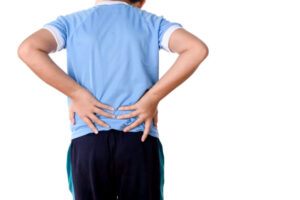Lumbar Spinal Stenosis
2022年5月11日
最終更新日時 :
2023年10月27日
 webmaster
webmaster
I will provide information on surgical methods, length of hospital stay, and insurance coverage for lumbar spinal stenosis.
Lumbar Spinal Stenosis
What is Lumbar Spinal Stenosis?
In the spine, there is a canal called the spinal canal located behind the vertebrae and intervertebral discs, which serves as a pathway for nerves. Over the years, as the spine undergoes deformities, this spinal canal can become narrower. When this narrowing occurs in the lumbar region, it is referred to as lumbar spinal stenosis. It typically begins to increase gradually after the age of 50, and it is considered a common condition, with approximately 10% of individuals in their 70s believed to have mild lumbar spinal stenosis.
Symptoms
When the spinal canal narrows, it can compress the nerves (such as the cauda equina and nerve roots) passing through it, leading to symptoms such as sciatica, which is characterized by nerve pain, numbness, and weakness in the lower extremities. At times, in addition to numbness in both lower limbs, individuals may experience symptoms related to the bladder and rectum, such as pelvic discomfort, a sensation of incomplete voiding after urination (urinary retention), and constipation. These symptoms are primarily triggered during periods of waking and walking. Consequently, in cases of lumbar spinal stenosis, individuals may find it difficult to walk long distances and may experience intermittent claudication, a condition characterized by walking followed by periods of rest. If walking exacerbates lower limb pain and numbness or if there are abnormal urinary symptoms associated with lower limb symptoms, lumbar spinal stenosis is suspected.
Treatment options
Symptoms and the site of narrowing classify it into cauda equina, nerve root, or mixed types. Cauda equina type often tends to be an indication for surgery. Conservative treatments such as medication (to promote nerve recovery or alleviate nerve pain) and block injections (sacral epidural or nerve root) can be effective in some cases.
For those who do not respond to conservative treatments and do not experience improvement, we recommend surgery.
For those who do not respond to conservative treatments and do not experience improvement, we recommend surgery.
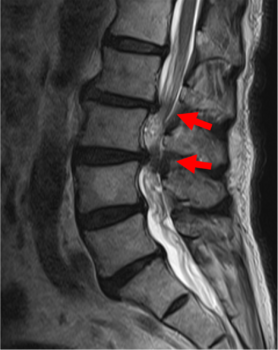
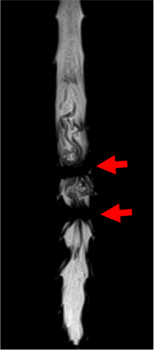
図1
Surgical procedures
Surgical methods are broadly categorized into decompression surgery and fixation surgery. In our facility, we prioritize minimally invasive endoscopic decompression surgery for decompression procedures.
Fixation surgery is indicated when there is instability or deformity such as scoliosis at the site of nerve compression, and it is further divided into posterior and anterior-posterior procedures:
Minimally Invasive Posterior Interbody Fusion (Mini-Open TLIF + PPS)
A fixation procedure involving the removal of the spinal canal pressure through a small midline skin incision, inserting an artificial spacer between the vertebrae, and inserting screws through a separate small incision on the side.
Minimally Invasive Anterior-Posterior Fixation (XLIF/OLIF + PPS)
A fixation procedure performed with a small (approximately 5 cm) incision on the side to insert an artificial spacer between the vertebrae and screws through a small incision on the back. It offers the advantage of indirectly decompressing the nerves without direct exposure.
There are also combined procedures that incorporate both 1) and 2).
Fixation surgery is indicated when there is instability or deformity such as scoliosis at the site of nerve compression, and it is further divided into posterior and anterior-posterior procedures:
Minimally Invasive Posterior Interbody Fusion (Mini-Open TLIF + PPS)
A fixation procedure involving the removal of the spinal canal pressure through a small midline skin incision, inserting an artificial spacer between the vertebrae, and inserting screws through a separate small incision on the side.
Minimally Invasive Anterior-Posterior Fixation (XLIF/OLIF + PPS)
A fixation procedure performed with a small (approximately 5 cm) incision on the side to insert an artificial spacer between the vertebrae and screws through a small incision on the back. It offers the advantage of indirectly decompressing the nerves without direct exposure.
There are also combined procedures that incorporate both 1) and 2).
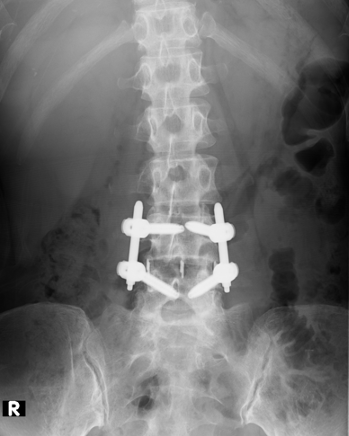
図2
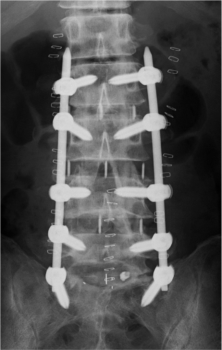
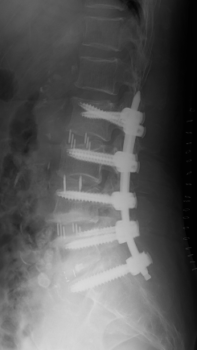
図3
